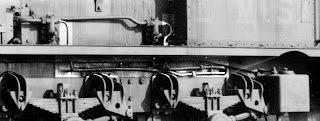This week, 'blogging the restoration of Sentinel 7109 led me to a whole new aspect of the restoration that I had not really thought much about before.
 |
| No comment! |
Simon Bowditch, chairman, thanked me and commented that it was the most detailed description of the workings of a Sentinel locomotive that he had ever come across.
My content included 7109's history and reasons for being at Midsomer Norton; details of the Sentinel boiler, superheater, chimneys, engines, feedpumps and chains plus additional material on other Sentinels and models. I interspersed a few video clips to provide variety from the pictures only. I also passed around some supplementary pictures and texts and brought a few of Joyce's renovated components for interest sake. The talk lasted about 1 hour 20 minutes including discussions on the way arising from audience questions.
So, having done it once, I have the basis to tailor the talk for other societies should they be interested. Please leave a comment with a phone contact number below if you would like to invite me to give a repeat performance.
Many thanks to the 82D society for inviting me.















